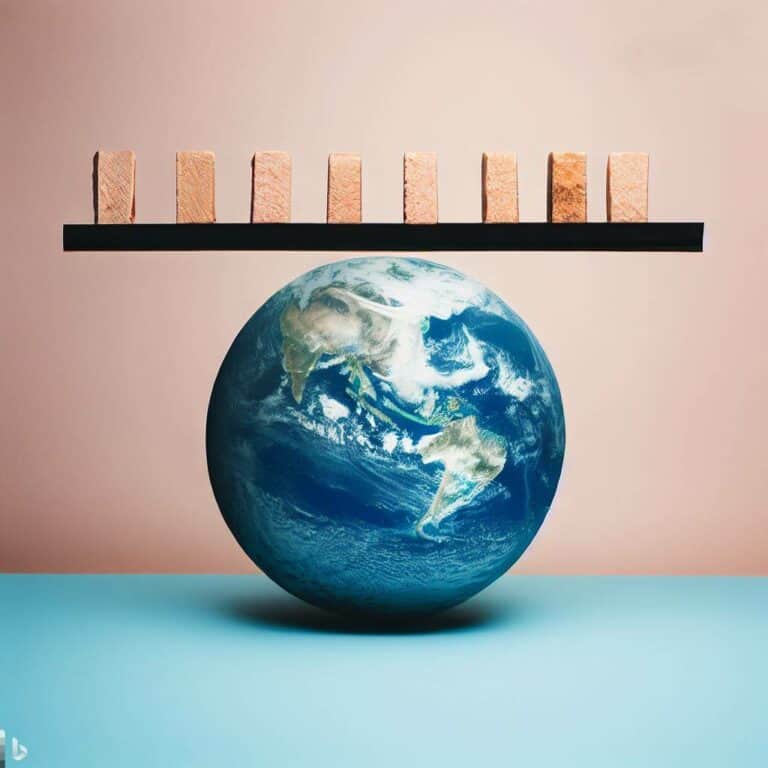Sustainable Yoga Mats: How Circular Economy is Transforming the Industry

As a long-time yoga practitioner, I’ve seen firsthand how the practice can transform the mind and body. Unfortunately, the production and disposal of yoga mats often leave a negative impact on the environment. Most mats are made from synthetic materials that can take hundreds of years to decompose and release harmful chemicals when incinerated. As someone who cares about the health of our planet, I believe it’s important to address this issue and find more sustainable solutions.
That’s where the circular economy comes in. This economic system is focused on keeping resources in use for as long as possible, minimizing waste, and maximizing value. Applying this concept to yoga mats can help reduce their environmental impact and promote a more sustainable industry.
In this article, I’ll explore the circular economy of yoga mats and how it’s transforming the industry. We’ll dive into topics such as sustainable and eco-friendly materials, circular economy and closed-loop systems, recycling and upcycling, and more. By the end of this article, I hope to show you that there are viable alternatives to traditional yoga mats and how you can make more environmentally-conscious choices as a consumer.
- Eco-friendly materials such as natural rubber, cork, jute, and recycled materials can be used to create sustainable yoga mats.
- To reduce the environmental impact of yoga mats, companies can focus on material efficiency, closed-loop systems, recycling, upcycling, sustainable sourcing, and green manufacturing practices.
- Adopting circular economy practices in the yoga mat industry can lead to cost savings, increased customer loyalty, longer-lasting and more sustainable products, and a more sustainable future for the environment.
Yoga mats – Sustainability and Eco-Friendly Materials
In recent years, there has been a growing demand for eco-friendly and sustainable yoga mats that minimize harm to the environment. Here are some of the materials that are being used to create these types of mats:
- Natural Rubber One of the most popular materials for eco-friendly yoga mats is natural rubber, which is biodegradable, renewable, and sustainable. Natural rubber mats are also durable, non-slip, and provide good cushioning for the joints. Companies such as Jade Yoga and Manduka use natural rubber in their mats, and some even offer mats made from recycled rubber.
- Cork Cork is another natural material that is used in eco-friendly yoga mats. It is sustainable, biodegradable, and provides good traction. Cork mats are also lightweight and antimicrobial, making them a great choice for yogis who practice hot yoga or sweat a lot. Companies such as Yoloha Yoga and CorkYogis offer cork yoga mats.
- Jute Jute is a natural fiber that is biodegradable and sustainable, and it has a rough texture that provides good traction. Jute mats are also lightweight and easy to clean. Companies such as Natural Jute Yoga Mat and Auroville offer jute yoga mats.
- Recycled Materials Many companies are now using recycled materials such as plastic bottles, tires, and even wetsuits to create eco-friendly yoga mats. By repurposing these materials, they are keeping them out of landfills and reducing their carbon footprint. Companies such as Suga and Liforme offer yoga mats made from recycled materials.
By using these sustainable and eco-friendly materials, we can reduce the environmental impact of yoga mats and promote a more circular economy in the yoga industry.
To learn more about the benefits of eco-friendly yoga mats and how to choose the right one for you, check out this article What makes a yoga mat eco-friendly?.
Life Cycle Assessment and Material Efficiency
When considering the sustainability of yoga mats, it’s important to evaluate their entire life cycle, from production to disposal. A life cycle assessment (LCA) is a tool used to evaluate the environmental impact of a product or service throughout its life cycle.
- Production The production phase of yoga mats can have a significant impact on the environment. To minimize this impact, companies can focus on material efficiency and reduce waste. By using less material, they can reduce their carbon footprint and overall environmental impact. Some companies, such as Manduka, have started using closed-loop systems that minimize waste and increase efficiency.
- Use During the use phase, yoga mats can become a breeding ground for bacteria and other germs. To reduce the environmental impact of cleaning and disinfecting mats, yogis can use eco-friendly cleaning solutions and avoid harsh chemicals. Additionally, using a mat towel or practicing on a natural surface can help reduce the amount of cleaning necessary.
- End of Life At the end of a yoga mat’s life cycle, it is important to dispose of it in an environmentally responsible manner. Many mats end up in landfills, where they can take hundreds of years to decompose. To reduce this impact, some companies offer recycling programs or take-back initiatives. For example, Jade Yoga has a program that recycles old mats into new ones.
By using life cycle assessment tools and focusing on material efficiency, companies can reduce the environmental impact of yoga mats and promote a more circular economy. Additionally, consumers can make more sustainable choices by opting for mats made from eco-friendly and sustainable materials, practicing on natural surfaces, and properly disposing of old mats.
To learn more about life cycle assessments and the environmental impact of yoga mats, check out this article What makes a yoga mat eco-friendly?.
Circular Economy and Closed-Loop Systems
The circular economy is a system where resources are kept in use for as long as possible, extracting the maximum value from them before recovering and regenerating materials at the end of their life cycle. In the context of yoga mats, a circular economy approach involves designing products that can be reused, repaired, or recycled, and keeping them out of landfills.
Closed-Loop Systems
Closed-loop systems are an important aspect of the circular economy. They involve designing products and processes that minimize waste by keeping materials in use for as long as possible. As mentioned earlier, some yoga mat companies, such as Manduka, have implemented closed-loop systems in their manufacturing processes. This approach helps reduce the environmental impact of production and encourages a more sustainable use of resources.
Product Design
Product design is another important aspect of the circular economy. By designing products with circularity in mind, companies can create products that are durable, easy to repair, and can be recycled at the end of their life cycle. For example, some yoga mats are now made from biodegradable materials, such as natural rubber, that can be composted at the end of their life cycle.
Reuse and Recycling
To promote circularity, companies can also offer reuse and recycling programs. As mentioned earlier, Jade Yoga offers a recycling program where old yoga mats can be sent back to the company to be recycled into new mats. Another example is Yoga Design Lab, which offers a mat rental program for yogis who want to reduce their environmental impact and minimize waste.
By embracing a circular economy approach, yoga mat companies can reduce their environmental impact and promote a more sustainable use of resources. Additionally, consumers can make more sustainable choices by opting for products made from eco-friendly materials, supporting companies with closed-loop systems, and participating in reuse and recycling programs.
To learn more about the circular economy and its role in sustainability, check out this article by the Ellen MacArthur Foundation.
Waste Reduction and Reuse
Waste reduction and reuse are key components of sustainability and the circular economy. In the context of yoga mats, waste reduction and reuse involve finding ways to minimize waste and extend the life cycle of products.
Biodegradable Materials
As mentioned earlier, some yoga mats are now made from biodegradable materials, such as natural rubber, that can be composted at the end of their life cycle. Biodegradable materials help reduce the environmental impact of production and disposal, and can also provide a source of nutrients for plants and other organisms.
Upcycling
Upcycling is the process of repurposing waste materials into new products of higher value. In the context of yoga mats, upcycling involves finding creative ways to reuse old mats, such as using them as padding or insulation. Some companies, such as Halfmoon, offer upcycling programs where old yoga mats can be sent back to the company to be repurposed into new products.
Donation and Sharing
Another way to reduce waste and extend the life cycle of products is through donation and sharing. Yogis who no longer use their old mats can donate them to yoga studios or community centers, where they can be used by others. Some studios also offer mat-sharing programs, where yogis can borrow mats instead of purchasing new ones.
By embracing waste reduction and reuse strategies, yoga mat companies and consumers can reduce their environmental impact and promote a more sustainable use of resources. Additionally, finding ways to extend the life cycle of products can help reduce the amount of waste that ends up in landfills.
Recycling and Upcycling
Recycling and upcycling are two methods of diverting waste from landfills and extending the life cycle of products. In the context of yoga mats, recycling and upcycling involve finding ways to transform old or worn-out mats into new products.
Recycling Programs
Several yoga mat companies, such as Jade Yoga, offer recycling programs for old mats. These programs allow yogis to send back their used mats, which are then recycled into new products. For example, Jade Yoga’s program grinds down old mats into a fine powder, which is then used to make new mats and other products.
Upcycling Upcycling
As mentioned in the previous section, involves repurposing old or discarded materials into new products of higher value. In the context of yoga mats, upcycling can involve cutting up old mats and using the material to make other products, such as coasters or bags. Some companies, such as Manduka, offer upcycling programs that allow customers to send back their old mats to be repurposed into new products.
Closed-Loop Systems
As discussed earlier, some companies, such as Manuka, have implemented closed-loop systems that allow for the recycling and reuse of materials in their products. These systems help reduce waste and promote a more sustainable use of resources.
By implementing recycling and upcycling programs, companies can reduce their environmental impact and promote a more circular economy. Additionally, recycling and upcycling programs can provide customers with an opportunity to dispose of their old mats in a sustainable and responsible way.
Sustainable Sourcing and Green Manufacturing
Sustainable sourcing and green manufacturing are important aspects of a circular economy, as they ensure that products are made using environmentally responsible practices and materials.
Sustainable Materials
The use of sustainable materials in yoga mats can significantly reduce the environmental impact of the production process. Some companies, such as Manduka and Jade Yoga, use natural materials like rubber and cork, which are biodegradable and renewable. Others use recycled materials, such as Halfmoon’s upcycled cotton and rubber mats.
Green Manufacturing Practices
In addition to using sustainable materials, many companies have implemented green manufacturing practices to reduce their environmental impact. For example, some companies use renewable energy sources, such as solar or wind power, to power their factories. Others use water-efficient production processes or prioritize the use of non-toxic materials.
Ethical Sourcing
In addition to environmental considerations, ethical sourcing is also an important aspect of sustainability. This involves ensuring that the materials used in yoga mats are sourced from suppliers who prioritize fair labor practices and ethical treatment of workers.
By prioritizing sustainable sourcing and green manufacturing practices, companies can reduce their environmental impact and promote a more circular economy. Additionally, these practices can help create a more ethical and responsible supply chain.
Consumer Behavior and Product Stewardship
In a circular economy, consumer behavior plays a crucial role in ensuring the longevity and sustainability of products. By adopting product stewardship practices, consumers can help extend the life of their yoga mats and reduce waste.
Care and Maintenance
Proper care and maintenance can help extend the life of a yoga mat. This includes cleaning it regularly and storing it in a cool, dry place when not in use. Additionally, using a yoga towel or practicing on a mat designed for hot yoga can help reduce wear and tear.
Repair and Reuse
When a yoga mat becomes worn or damaged, it’s important to consider repair or reuse options before discarding it. Some companies offer repair services, and there are also DIY repair kits available. Alternatively, old yoga mats can be repurposed for a variety of uses, such as padding or insulation.
Recycling and Disposal
When a yoga mat has reached the end of its life, it’s important to dispose of it properly. Many companies, such as Jade Yoga and Manduka, offer recycling programs that allow customers to send in their old yoga mats for recycling. Additionally, some municipalities offer recycling programs for yoga mats, or they can be recycled through specialized recycling centers.
By adopting product stewardship practices, consumers can help reduce waste and promote a more sustainable and circular economy. Additionally, choosing companies that prioritize sustainability and ethical practices can help drive change in the industry.
IX. Case Studies and Success Stories
Many companies and organizations in the yoga mat industry have successfully implemented circular economy principles, demonstrating the benefits of adopting sustainable practices.
Jade Yoga
Jade Yoga is a company that has made sustainability a priority since its inception. In addition to their recycling program, Jade Yoga uses natural rubber, a renewable resource, in their mats. They also partner with Trees for the Future to plant a tree for every mat sold. By prioritizing sustainability and implementing circular economy practices, Jade Yoga has become a leader in the industry.
Manduka
Manduka is another company that has made significant strides in sustainability. Their closed-loop manufacturing system reduces waste and ensures that materials are reused as much as possible. Additionally, they offer a recycling program for old yoga mats. By prioritizing sustainability, Manduka has not only reduced their environmental impact but has also attracted customers who value ethical and sustainable practices.
Halfmoon
Halfmoon is a company that offers an upcycling program for old yoga mats. By repurposing old mats into new products, such as coasters and tote bags, Halfmoon reduces waste and extends the life of their products. This program has been a success both in terms of sustainability and customer engagement.
The benefits of adopting circular economy practices in the yoga mat industry are numerous. For manufacturers, it can lead to cost savings, increased customer loyalty, and a positive brand image. For consumers, it means longer-lasting and more sustainable products. And for the environment, it means reduced waste and a more sustainable future.
By highlighting these case studies and success stories, I hope to inspire more companies and organizations in the yoga mat industry to adopt circular economy practices and promote sustainability.
Conclusion
In conclusion, the yoga mat industry has the potential to make significant strides towards sustainability by adopting circular economy practices. By implementing sustainable sourcing, green manufacturing, and waste reduction and reuse, manufacturers can reduce their environmental impact and create more sustainable products. Consumers can also play a role by supporting companies that prioritize sustainability and practicing product stewardship.
In this article, we have covered ten key topics related to the circular economy of yoga mats. We have discussed the importance of using eco-friendly materials and conducting life cycle assessments, as well as the benefits of closed-loop systems and waste reduction and reuse. We have highlighted case studies of companies such as Jade Yoga, Manduka, and Halfmoon, who have successfully implemented circular economy practices in the yoga mat industry.
It is now up to us as consumers to support these companies and advocate for more sustainable practices in the yoga mat industry. By choosing eco-friendly mats, practicing proper product stewardship, and encouraging manufacturers to prioritize sustainability, we can create a more sustainable future for the yoga mat industry and the planet as a whole.
Let’s work together towards a more sustainable and circular economy for yoga mats.





